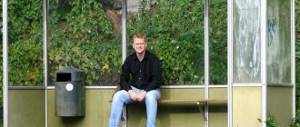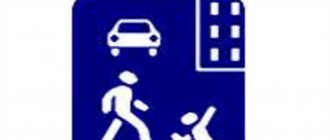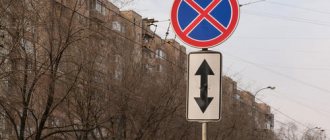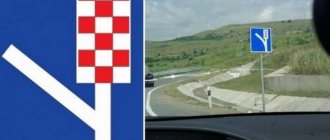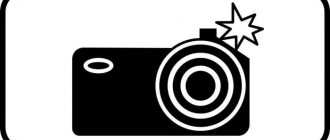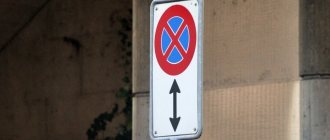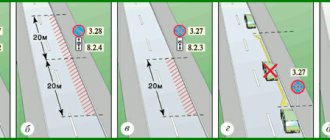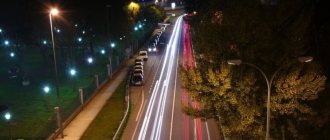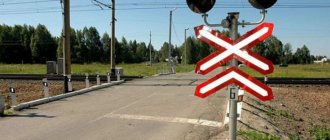Can you stop at this location to pick up or drop off passengers?
| 1. | Yes. |
| 2. | Yes, if you do not interfere with the movement of route vehicles. |
| 3. | No. |
Markings in the form of a yellow zigzag line are used to mark the stops of route vehicles and taxi ranks. In this situation, you can stop to pick up or unload passengers in the marked area if you do not interfere with the movement of shuttle buses or trolleybuses.
Extreme care and great responsibility
It is no secret that many careless drivers neglect not only the speed limit, but also compliance with road signs. For example, a sign indicating the stop location of a city bus or trolleybus should increase the discipline of all road users.
Based on Russian traffic rules, all signs indicating the presence of a bus stop must be double-sided. Naturally, such an important condition is provided so that all cars (passing and oncoming) that are currently present on the road can see the corresponding sign from afar and be informed about the nearby stop of public passenger transport. All this is aimed at ensuring that drivers can take the necessary safety measures in a timely manner. In particular, when approaching a stop, reduce your speed, wait before overtaking, increase your alertness for the possible presence of pedestrians crossing the road, and maneuver exclusively according to traffic rules.
According to the new rules, the “Bus Stop” road sign can be used in conjunction with a certain road surface marking, i.e. there must be a yellow broken line drawn on the road in a strictly horizontal direction. Such a specialized area also indicates a stop for public buses and trolleybuses.
Often the “Bus Stop” sign duplicates the markings
You should not neglect the rules on the road, even if there is a chance that an improvident car owner will not be noticed and will not be fined, there is no need to create emergency or simply uncomfortable situations for other road users. The sign indicating a bus stop is discussed in detail in sections 8 and 12 of the Russian Federation Traffic Regulations. Where it is said that in places where public vehicles stop, certain unsafe maneuvers are strictly prohibited. First of all, you cannot drive backwards and make U-turns, and secondly, you cannot park or even stop the car at a distance closer than 15 m. Moreover, the last condition provides for a ban on stopping not only before, but also after the sign. However, this paragraph has one caveat: a car that does not interfere with the movement of a route vehicle can make a short stop to disembark/pick up passengers in the coverage area of the sign indicating a bus stop.
This line indicates:
| 1. | A section of road where driving close to the sidewalk is prohibited. |
| 2. | Bus stops and taxi ranks. |
| 3. | Places where any stopping is prohibited. |
This yellow marking line 1.17 indicates stopping places for route vehicles and taxi stands, where stopping of other vehicles is possible only for boarding and disembarking passengers, provided that this does not interfere with the movement of route vehicles.
MTS stop sign only
8.11. U-turn is prohibited:
in places where route vehicles stop.
12.4. Stopping is prohibited:
closer than 15 meters from the stopping places of fixed-route vehicles or parking for passenger taxis, indicated by marking 1.17, and in its absence - from the sign of the stopping place of fixed-route vehicles or parking for passenger taxis (except for stops for boarding and disembarking passengers, if this does not interfere with the movement of fixed-route vehicles vehicles or vehicles used as passenger taxis);
The MTS stop location is indicated only by a sign.
Please note that the MTS stop location begins after the sign. According to GOST, sign 5.16 is installed at the beginning of the landing area, that is, the stopped route vehicle will be located completely after the sign. This prevents the bus from blocking the visibility of the sign. This is important when making a turn. Turning around before the sign is not prohibited. Turning is prohibited only at MTS stops - from the far right lane and into the far right lane.
- If the stopping place for route vehicles is indicated only by a sign, then the prohibited stopping and parking zone is determined by 15 meters before and after the sign in the direction of travel for which the sign is installed. Stopping on the opposite side of the road is not prohibited.
Stop on the opposite side of the road from the MTS stop
Are you allowed to stop to disembark passengers at the specified location?
| 1. | Allowed. |
| 2. | Permitted if there is no interference with the movement of route vehicles. |
| 3. | Prohibited. |
Since stopping on the left side of a road with one lane in each direction is allowed in populated areas, you can stop at the indicated place, but only to pick up or unload passengers and provided that this does not interfere with the movement of route vehicles.
White, orange, yellow
Currently, markings applied to the road surface in the Russian Federation can be of three colors. This is provided for by the current edition of the traffic rules. In particular, it happens:
- white;
- orange;
- yellow.
The markings also warn of approaching dangerous areas or certain road signs.
In most cases, it comes in the usual white color. These markings divide the roadway into traffic lanes and mark the edges of the road. Depending on the situation, the line can be solid or broken. The first one, as you know, cannot be crossed. Well, the most serious fines are issued when vehicle drivers make any maneuver through a double solid line. White markings also mark pedestrian crossings and stop lines, including those in front of traffic lights.
The orange color in the vast majority of cases indicates the temporary nature of the markings. Such markings are usually applied in front of areas where some kind of road work is being carried out. This is done to ensure the safety of road users. It is easy to guess that after the completion of road work, the markings are returned to their original appearance. By the way, orange always has priority over white, since it is the one that is considered relevant at the moment.
It's a little more complicated with yellow markings. Firstly, it can highlight traffic lanes to improve visibility. In this case, drivers should comply with all requirements, as in the case of white. If yellow markings are painted on the curb, near it or on the side of the road, this means that parking or stopping a vehicle in this area is prohibited. It is often supplemented by a corresponding road sign.
Therefore, be careful when parking. There were cases when the paint was not renewed on time, and it was difficult to see its color. However, it will be quite difficult for you to prove that you are right to the inspector. Therefore, if in any doubt, it is best to park your car somewhere else. In large populated areas, an incorrectly abandoned car may well be picked up with the help of a tow truck.
A broken yellow line painted on the curb, near it or on the side of the road allows parking, but the parking time of the car in such areas should not exceed 5 minutes. In most cases, this marking is an addition to road sign 3.28, which allows the vehicle to stop for the purpose of boarding or disembarking passengers. It also does not prohibit parking in emergency cases - if the car breaks down, or in any unforeseen situation. The latter, for example, include insurmountable obstacles that arise on the road, or health problems with the driver of the vehicle.
If broken or solid yellow lines are painted along the right edge of the roadway outside a populated area, then the driver will be prohibited from stopping or parking there. One point worth noting. The restriction applies along the entire length of the line. That is, as soon as it ends, all prohibitions and restrictions are lifted.
A zigzag yellow line painted on the roadway indicates a public transport stop. Such markings are quite noticeable - they catch the eye faster than the corresponding road sign. Naturally, vehicle drivers are prohibited from stopping and parking in such areas. The exception here is route and regular taxis.
Finally, I would like to give some advice. Firstly, don’t be lazy to learn about changes made to traffic rules. The rules do not change very often, but they do change. Well, knowledge, as we know, does not relieve one from responsibility. In addition, when driving on the road, always strictly follow the rules. After all, the safety of both yours and other road users depends on it.
You should not neglect the requirements of traffic rules, hoping that it will “sweep by” and no one will notice your violation. The rules were written taking into account many years of experience, and are aimed, first of all, at maintaining order on the roadway and ensuring the safety of all traffic participants. Sometimes an incorrectly parked car can cause an accident. Therefore, always think not only about yourself, but also about other drivers.
Penalties for violating the rules
If for any reason the car owner had to stop directly at the bus stop itself, the traffic police officer who noticed this offense is authorized to issue a fine, the amount of which will be about 1000 rubles. In central regions such as Moscow or St. Petersburg, the amount of monetary compensation is three times higher: the driver will have to pay 3,000 rubles.
The road sign “Bus Stop Place” should warn motorists about the prohibition of stopping on a certain section of the roadway. Without special need, you cannot stop your vehicle not only in the bus “parking lot”, but also within the 15 meters that precede and terminate it. This distance, equal to 15 meters, should be counted directly from the sign indicating the presence of a shuttle bus stop. In the event that such a sign is not visible or is not there at all, the distance must be “measured” from the pocket and markings.
Failure to comply with parking rules may result in a fine.
In addition to a monetary penalty, a driver who neglects traffic rules may face another problem - the car may be towed to a specialized impound lot. As a result, a person, in addition to a fine, will be forced to pay additional costs associated with transporting and storing his car in the parking lot. In such a situation, naturally, it will be better for the driver of the vehicle if he is nearby and can independently remove the obstacle created by his car. In this case, the car will not be evacuated; the owner will be able to independently rearrange it and drive it away from the unsuitable location.
